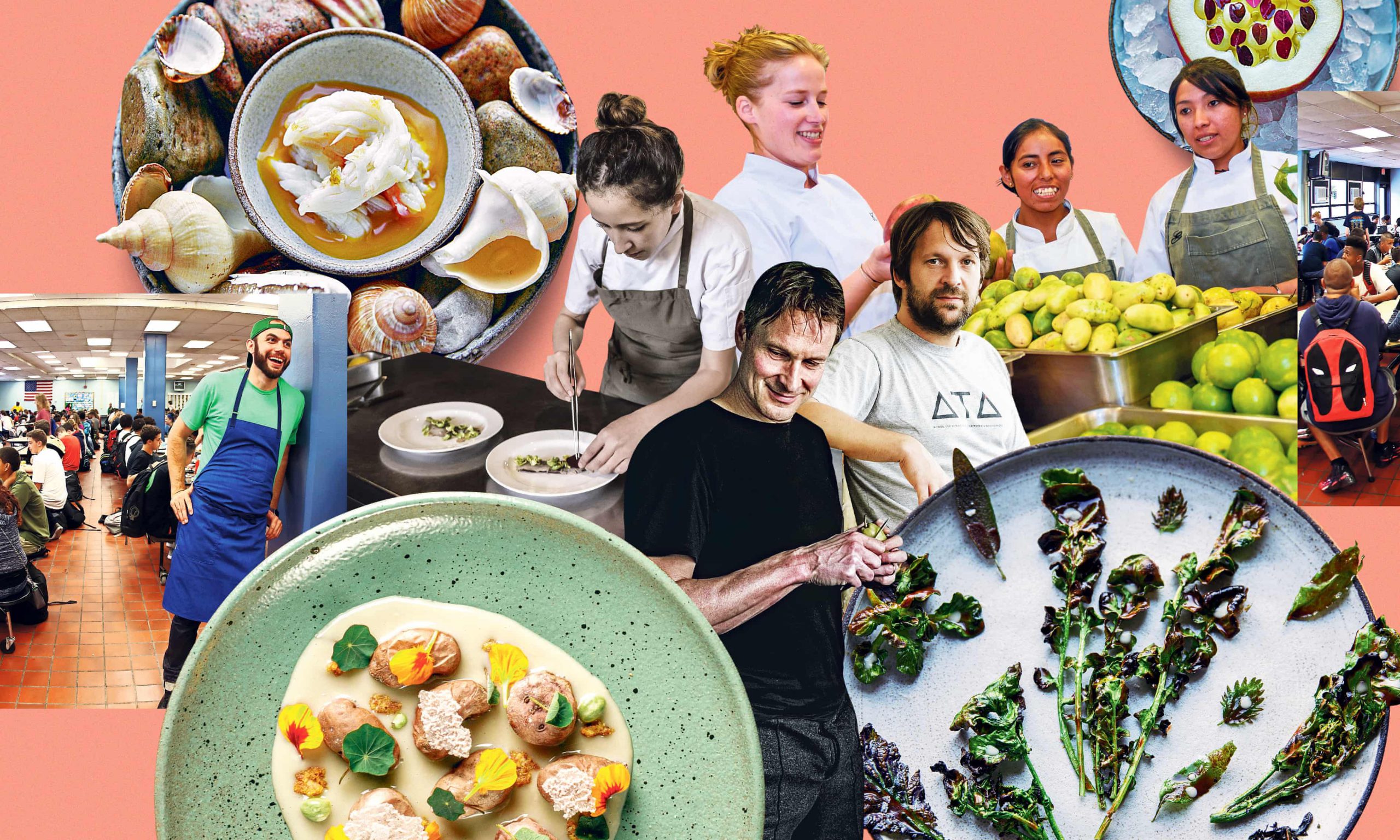From Beirut With Love: Souk El Tayeb
Last summer, we were finally able to bring the members of Souk El Tayeb, Lebanon’s first farmers market, to MAD. It was something we had dreamed about since 2011, when the community organizer Kamal Mouzawak spoke at the first symposium, introducing the audience to his organization and its guiding principle, “Make Food, Not War.” In the following essay, which appears in Lucky Peach’s MAD mini-magazine from the 2013 Chefs and Cooks Issue, Rachel Khong takes us back to Souk El Tayeb’s magical lunch on day one of the 2013 symposium. Added bonus: she’s included a recipe from Maria Doueihi, a member of Souk El Tayeb’s educational kitchen Tawlet.
Picture lunchtime on a sunny day on a grassy island in Copenhagen. Laid before you are enormous platters of Middle Eastern fare: salads bright with green herbs and pink pomegranate seeds, kibbeh, fattoush, tabbouli, baba ghanoush, and manoush being patted into rounds and spread with za’atar and thyme and cooked on the spot. There are, on top of that, some guts-themed offerings: fried lamb testicles, beef tongue in coriander and garlic sauce, little sausages made from segments of goat intestine. When you reach the end of the buffet line, the heap of food on your paper plate is so mountainous your wrist hurts to hold it. You eat fast for fear that the food might fall through the plate. And though the foods aren’t all familiar, they’re somehow entirely comforting anyway.
The cooks responsible are seventeen ladies—plus a ponytailed man named Fadi—here from Lebanon. For eight of them, this trip is their first out of the country. All the women are mothers from the Souk El Tayeb, Beirut’s first farmers’ market.
But “farmers’ market” doesn’t do justice to all Souk El Tayeb is and does: started in 2004, Souk El Tayeb is part market and part educational kitchen (called Tawlet, where a cook will purvey a buffet of her regional cuisine), all with the goal of promoting rural agriculture, preserving Lebanese culinary traditions, and “making food, not war.” It’s a place where cooks—many of them women—from Lebanon’s whole spectrum of backgrounds, regions, and religions come together to cook and share what they’ve cooked.
I met the ladies the first morning of MAD, while they were busy in the prep kitchen: pushing testicles around in pans of butter, washing massive amounts of mint, stuffing goat intestines with rice and meat. Zeina was athletically stirring an enormous pot of wheat porridge, hrisset djeij, and Raja, who is Palestinian but currently living in a refugee camp in Lebanon, fed me sample after sample of the musakhan she’d made—small bread rolls stuffed with chicken and tangy with sumac. There was plenty left to do, but you wouldn’t know it from looking at them: they couldn’t be having a better time. As they prepped ingredients they talked and laughed and I regretted not knowing Arabic, because it seemed like I was missing out on a lot of good jokes.
We caught up after lunch. I met Sona, who made the lentil balls, and Josephine, who made the samke harra, a garlicky, lemony, cilantro-y fish salad, covered in fried almonds and pine nuts (which I loved a lot and could’ve probably eaten the whole platter of). I met Suzanne and Georgina and two Rimas and Fadi, who was clearly enjoying being the only man-cook around. I met Maria, who said the kibbeh was best from Zgharta, in Northern Lebanon, where she was from, and did I want to know how to make it? What was clear from talking to them was that they all loved to cook, and were all very proud of their national dishes. And whose recipes were they using? “They are all our recipes,” Maria said.
RECIPE: MARIAH’S KIBBEH
Makes 8 Servings
Our cuisine has a lot of variety. When you go to a restaurant in Lebanon and you ask for the appetizer, they’ll bring you forty or fifty dishes to start. They bring you the main course when you are full and can’t eat anymore. Lebanese people love living. They enjoy living, they are open-minded, they speak different languages, they are helpful to each other—communicative people.
Before the problems, it was like living in paradise. The nightlife, the beaches, skiing in the mountains. We have very nice weather. In half an hour you can go from the sea to the mountain. There are all kinds of restaurants—French, Italian—they are all very good. And there is a lot of culture of many religions, Christian and Muslim, and it creates a culture that is very rich. They used to live together in the same area, now it’s not the same anymore because of the fundamentalism. I got there in 1975, at the beginning of the war. It was hell, and then it became very peaceful and very good. The Lebanese, they get used to this—it’s bombing now, tomorrow all the nightclubs and restaurants are full. They don’t give up on living. They love living.
I love cooking. For me, cooking is a joy. My father was very famous in Lebanon, doing patisserie—oriental pastry. He was a master of it. So I mastered the salted side. I’m not for sugar, not for sweets, but I still became like my father, who had a lot of tips for everything. My mother, my sister, they’re very good—my grandmother, too. It’s in the family, I think. My sister-in-law, whatever she cooks, she puts the same ingredients. It’s not good.
From the smell, I can feel my food, and I can put exactly what makes it better—by experience. When I got married, I was nineteen. Then I started learning. I lived in Venezuela; the people of Venezuela love the Lebanese food. My friends would say that twenty-four hours before I cooked they didn’t eat anything. When you like to cook, it becomes good. I enjoy people eating when I prepare something, I enjoy them eating and to take everything with them. Take it, take it! I love it.
Where I live, in Zgharta, we are famous for our kibbeh. It’s best from our region. My grandmother would use a mortar—a big wooden mortar—and pound the meat with water. They used to make the kibbeh like this, and I used to sit there with my grandmother. —Maria Doueihi
INGREDIENTS AND PROCESS
2 lbs goat or beef (The meat should be red and hard, not soft. The best raw kibbeh is from goat. Younger goat is better. With cooked kibbeh, it’s less important, but for raw kibbeh, young goat meat is best. Tell your butcher you want the leg. If you’re using beef, ask the butcher to get the pieces from the side or from the leg, where the meat is hard and lean.)
+ ice
1 C fine burghul (bulgur). Find the very small, very soft kind of burghul. There are two or three different sizes. Don’t use the big one; find the smallest one.
+ salt
+ white pepper
+ dried red pepper (optional)
+ olive oil
+ mint
+ onion (green or red)
The day before you are going to make kibbeh, trim the fat from the meat. You don’t want anything white; you want to have pure red meat. The kibbeh we made at MAD was from young beef, but it can be beef or goat. Whether it’s beef or goat, clean it very carefully. Pure red, no white. Cut the meat into 1” cubes, and lay them out on a cookie sheet. Put the meat in the freezer overnight.
Wash the burghul in cold water. Wring the wet burghul one handful at a time until the white comes out of it. Put it in the fridge overnight. It should be very cold. If you’ve forgotten to do this and run out of time, you can also put the burghul in the freezer for 15 minutes.
On the second day, move the meat to the fridge for a few hours. When you’re ready to prepare the kibbeh, place the firm meat in a food processor along with a few pieces of crushed ice. Run the machine. When you see it starting to come together, season with salt. The salt, water, and ice will help the meat to stretch. It will become red, very nice. Add burghul little by little to the machine with a little water, brrrrrrrl,until you feel it come together completely, and the two marry. It should be not too hard, not too soft. For a kilo of meat, for example, you’ll put a little bit more than a cup of burghul to achieve the right texture.
If you don’t have a food processor, you can mix it with your hands, but with the machine it only takes 2 minutes.
Season with white-pepper and salt. If you want to add some hot red pepper, it gives a very nice taste.
To finish the kibbeh, put it in a dish, and top it with plenty of olive oil. Eat raw kibbeh with bread, never with a fork. It tastes like nothing with a fork. Any kind of bread you like will work, but pita bread is best. Put your kibbeh and a few leaves of mint in the bread, take a bite, and follow with a bite of green or red onion. If you don’t want onion, no problem.




